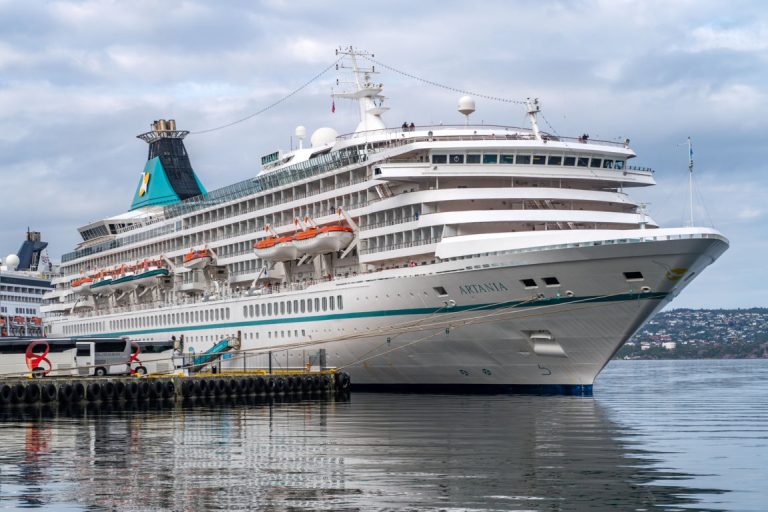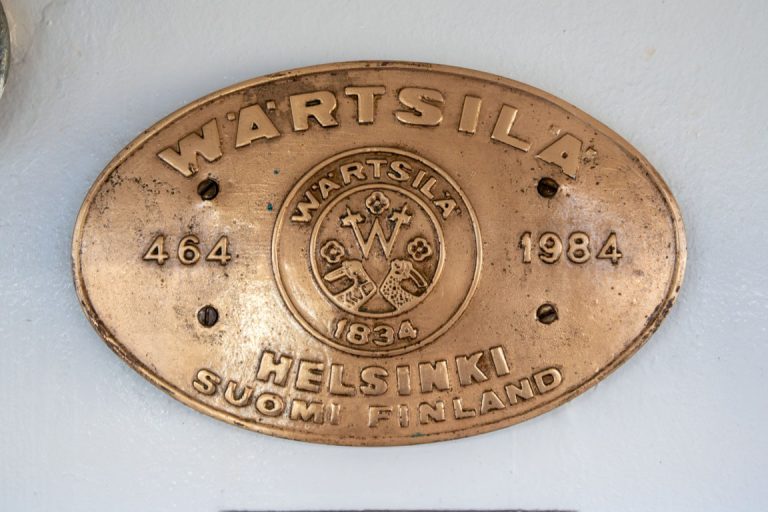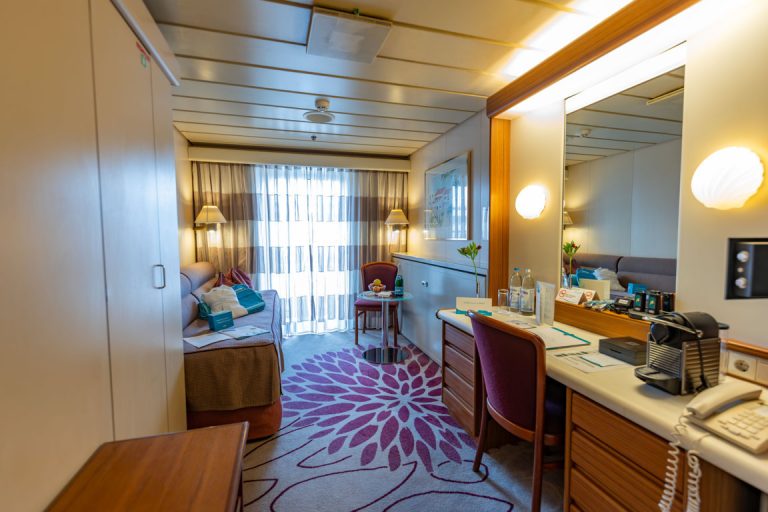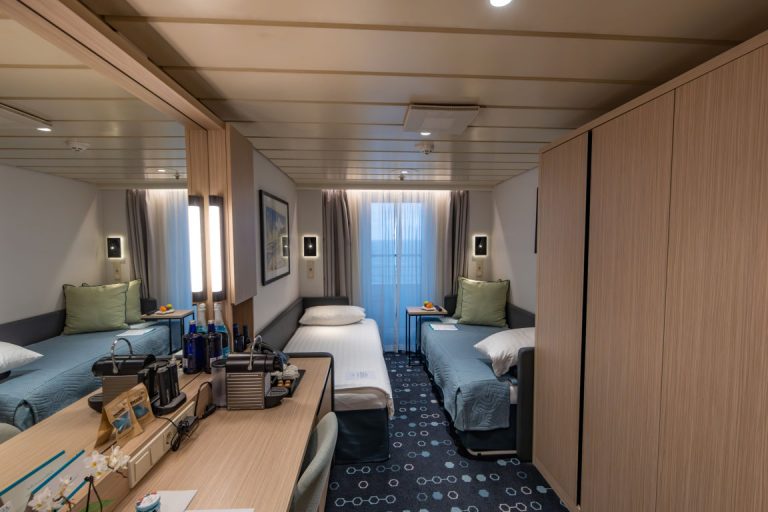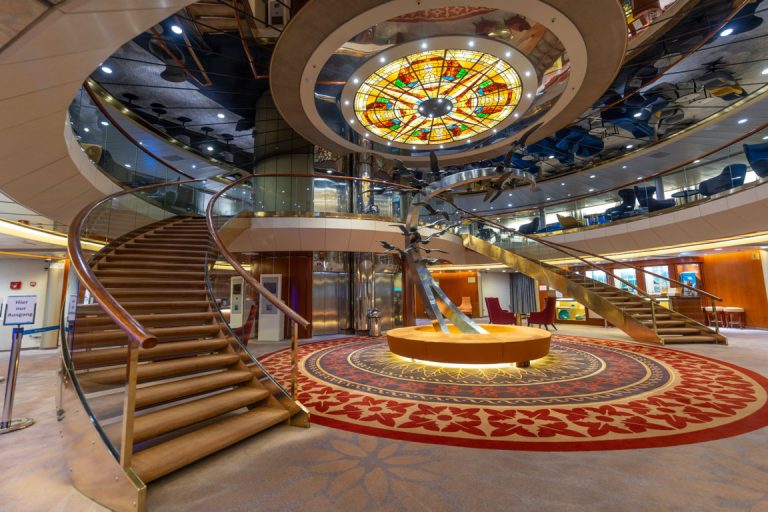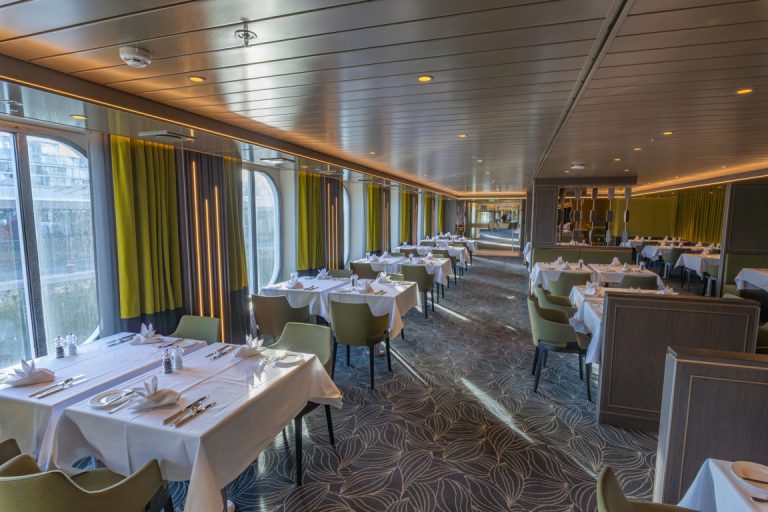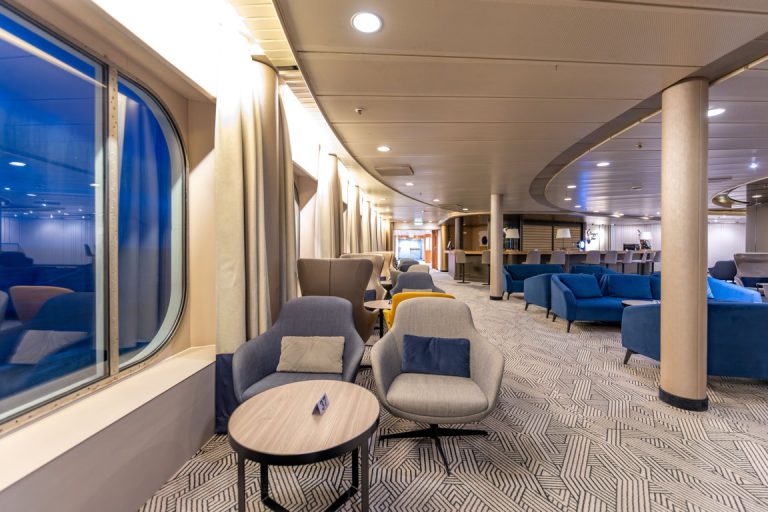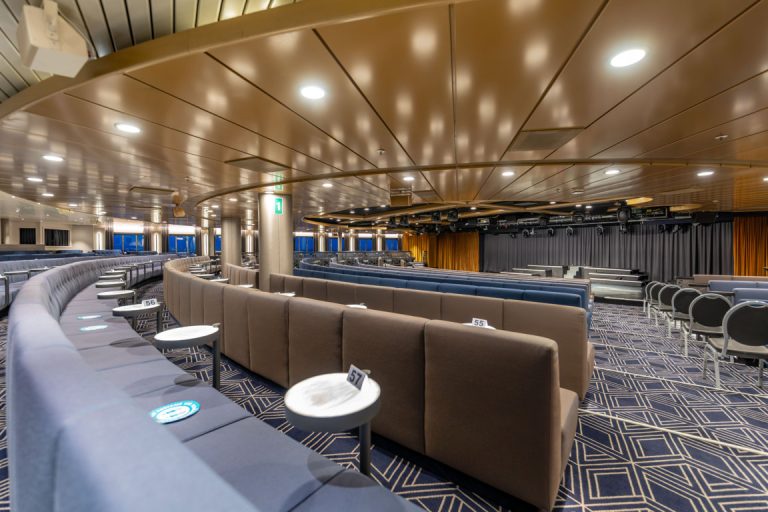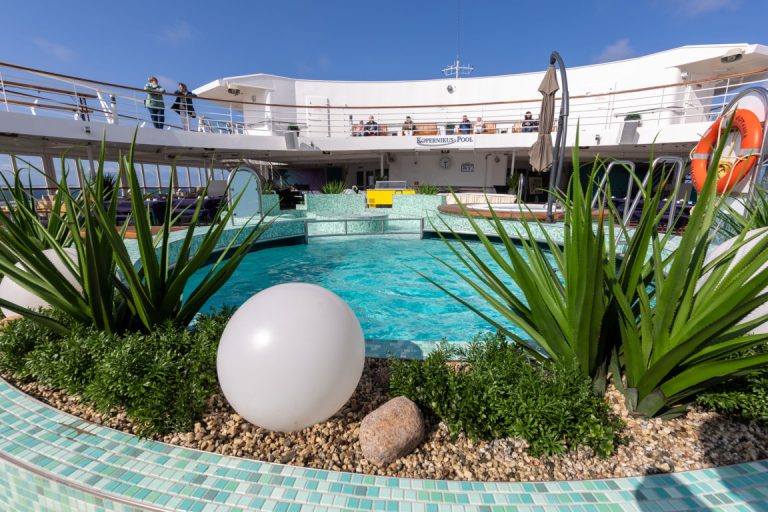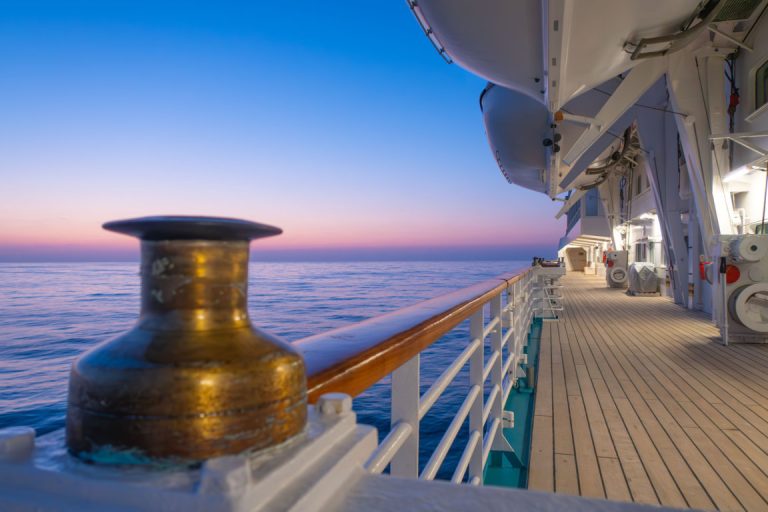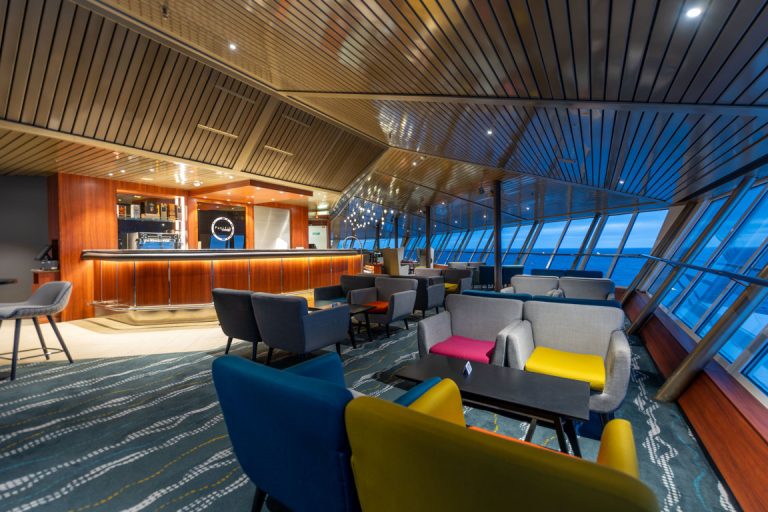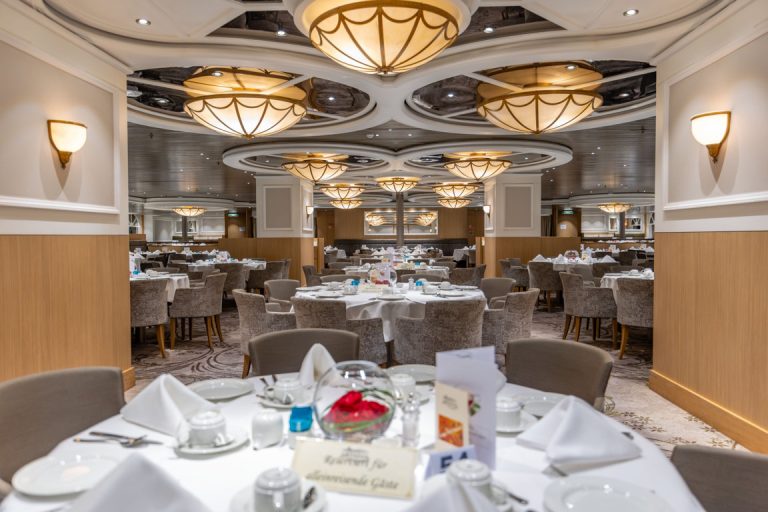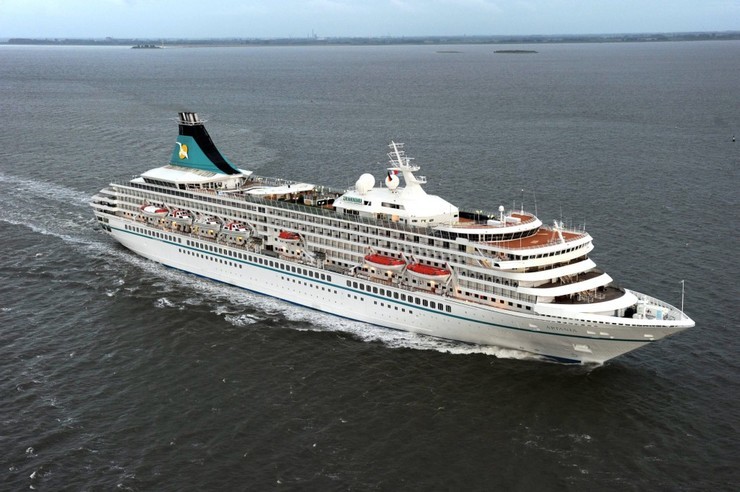Artania: a unique and regal piece
In a cruise world where, for many decades, and even more so in recent years, large fleets of nearly identical sister ships set the trend, it is truly a rarity when a cruise line’s fleet consists exclusively of “one-of-a-kind” ships. The operator Phoenix Reisen, based in Bonn, Germany, represents one of these rarities, as each of its four cruise ships is unique in its own way.
Founded 52 years ago, the company has traditionally operated second-hand ships, in which it has continued to invest over the years. In addition to its flagship Amadea (built in 1990 for the Japanese company NYK Cruises), the Amera (built in 1988 for the Royal Viking Line), and the Deutschland (a seasonal charter vessel, built in 1998 for Peter Deilmann Reederei), since 2011, the Artania has also been part of the Bonn fleet.
ARTANIA at Bergen, Norway
Building Plate
In 1965, Stanley McDonald, a Canadian-born entrepreneur, founded Princess Cruises to offer cruises along the west coast of the United States. Initially, the company operated trips from Los Angeles along the Mexican Riviera using chartered ships, but just a few years later, it expanded into Alaska as well. In 1974, McDonald sold the company to P&O (Peninsular & Oriental Steam Navigation Company) but remained president until 1980. Under P&O’s management, Princess Cruises grew rapidly. The British company introduced the Sun Princess, a ship built just two years earlier, and also acquired the young Island Princess and Pacific Princess from Flagship Cruises. In the same year, Jeraldine Saunders published her autobiographical book The Love Boats, which recounted her experience as a cruise director. This book was later adapted into the famous television show The Love Boat, which aired starting in 1977 and significantly contributed to Princess Cruises’ visibility.
It took another ten years after P&O’s acquisition of Princess Cruises for the company to receive its first true newbuild: the Royal Princess. Built at the Wärtsilä shipyard in Helsinki and launched in the fall of 1982, the Royal Princess would set new standards in cruise ship design. Delivered on October 30, 1984, and based in London, it was christened on November 15 of the same year in Southampton by Princess Diana, the consort of the British heir to the throne.
The construction costs of the Royal Princess amounted to 165 million dollars, which corresponds to a value of nearly 500 million dollars today. The Wärtsilä shipyard, with locations in Turku and Helsinki, was considered one of the most renowned shipyards for the construction of modern passenger ships at the time. For example, in 1977, it built the Finnjet, an innovative passenger ferry, and in the early 1970s, it constructed three luxury cruise ships for Royal Viking Line. The highly innovative design of the Royal Princess for its time featured a complete absence of interior cabins for passengers, with two decks equipped with balcony cabins. Additionally, the layout placed the public areas quite low on the ship, with most of the passenger decks above them—still a standard for cruise ships today. The Royal Princess, with a length of 230.61 meters and a tonnage of 44,458 GT, could accommodate 1,188 passengers. Propulsion was provided by four main S.E.M.T.-Pielstick 6PC4-2L engines built under license by Wärtsilä, generating a total power of 23,200 kW, which drove two four-bladed adjustable propellers. The maximum speed was 22 knots.
Balcony stateroom before renovation (no longer on offer)
Balcony stateroom after renovation, current status
In 2003, P&O Princess Cruises and Carnival Corporation merged to form a dual-listed company, Carnival Corporation & plc. Within the portfolio of brands of what became the world’s largest cruise company, the Royal Princess was transferred in 2005 to the British market under the P&O Cruises brand, taking on the name of the ancient Greek goddess of the hunt, Artemis, whose Roman name is Diana – certainly a not-so-coincidental choice! In 2009, Phoenix Reisen, which had already had its eye on the ship for some time, managed to secure the Artemis for delivery in April 2011. The tour operator from Bonn has always acted solely as a charterer, while the management of the ship was entrusted to third parties, initially to V.Ships and today to BSM Cruise Services, for what is now called Artania.
Before embarking on its first voyage for Phoenix Reisen on May 28, 2011, the Artania headed to the Lloyd Werft shipyard in Bremerhaven. In order to provide a free flow on a ship originally designed for two seating times, the aft lounge was transformed into a second main restaurant called Artania, and the buffet restaurant was completely renovated. As it turned out, the previous owners had invested very little in maintaining the ship in recent years, and several “issues” emerged during the shipyard stay. However, the inaugural voyage for Phoenix Reisen departed on time, although some work remained to be completed.
The Artania replaced the Maxim Gorkiy at Phoenix Reisen, which was scrapped in 2009. This ship was also considered, in its time, a true “spaceship,” a feature that its successor maintained, now extending to the third dimension. While the Maxim Gorkiy was very spacious in terms of surface area, the low height in the public areas somewhat limited this feeling.
Let’s take a look at the ship: very low down, on deck 1 (Mercury Deck), are almost exclusively crew areas, but here is also the onboard hospital. Above, on deck 2 (Neptune Deck), are the first passenger cabins, all equipped with windows, not just portholes. Next is the lobby, in the center of which stands the striking steel and bronze sculpture “Spindrift.” This original 1984 work, created by British artist David Norris, who was awarded the Otto-Beit Medal of the Royal British Society of Sculptors for its creation, depicts a flock of seagulls and fits perfectly into the ambiance of a Phoenix ship. Although the Artania lobby does not feature panoramic glass elevators, the two “open” elevators near the Spindrift statue can justly be considered the forerunners of this later trend. Around the lobby are the reception (forward), Phoenix information (to the right), and the excursion office (to the left), while at the stern is the entrance to the Vier Jahreszeiten restaurant. Previously called Coral Dining Room on the Artemis, this was the ship’s only main restaurant.
Lobby with Spindrift
Pichler’s Restaurant
On deck 3 (Salon Deck), around the central opening of the lobby, is Harry’s Bar. When it was still called Tiffany’s Bar in the days of Artemis – referencing the Tiffany glass ceiling above the Spindrift sculpture, which had been installed during the redesign from Royal Princess to Artemis – this area featured a small “memorial” to the original godmother, Princess Diana. Moving towards the stern, two large indoor promenades pass by the spacious boutique and lead to the new Casablanca Bar. In the same space, on the Artemis, were the casino and the Cyb@study, an internet café and computer learning center. The Casablanca Bar, with its stylish and modern décor, offers a mix of high bar stools and comfortable lounge areas. Near the large counter, there is a small dance floor. Continuing from the large aft staircase, two new areas can be accessed. On the left (port side), there is the new themed restaurant Pichler’s, opened at the end of 2024, which replaced the former Bodega Bar. Here, a special free menu can be enjoyed, but a reservation is required. On the right (starboard side), there is the entrance to the Artania restaurant, probably the largest single investment during the refitting from Artemis to Artania. Until April 2011, this space housed the Starlights Lounge, which served as a second show room for the ship, featuring a small stage, a large dance floor, and at the very stern, a small chapel for weddings. On the left, this room was directly connected to the Century Bar (now Pichler’s restaurant). This space proved perfect for creating a new restaurant, as the ship’s main kitchen is located directly below. To ensure “short paths” for service, escalators were installed that connect the restaurant to the kitchen. The new dining room is very spacious, with plenty of space around the tables, and was renovated during the ship’s last stay in dry dock in the fall of 2024.
Casablanca-Bar
Harry’s Bar
At the entrance of the former Starlights Lounge on the Artemis, there was also the onboard library, which has since been moved to deck 7 (Jupiter Deck) at the front, before two new balcony cabins were installed there. Today, on the Salon Deck, access is from Harry’s Bar on the right side (starboard) to the new combined area that serves as a library, internet café, and card room. Also on the right side is the entrance to the windowless onboard cinema, which can also be used as a conference room and seminar space. This is the last public area on the Artania that remains almost identical to how it was on the Artemis. If there are enough “young cruisers” on board, the cinema sometimes becomes the meeting point for events and activities organized by the Phoenix team. There are no spaces dedicated exclusively to children and teenagers on the Artania. On the left side (port side), the photography gallery is located next to the cinema. Right at the front of this deck is the Atlantik Show Lounge with an attached bar. Since the Royal Princess was originally built as a ship with two seating times, the Atlantik Show Lounge is unfortunately quite small compared to the total number of passengers.
Atlantik Showlounge
Cinema
On deck 4 (Saturn Deck), you can circumnavigate the entire ship along an external teak promenade. One of the highlights of the Artania is located aft on this deck: in a previously underutilized external area, a passage to a crew-only lower deck has been closed, creating a large outdoor space for the current Phoenix Bar. This corner offers comfortable lounge seating and a bar counter with bar stools right near the aft railing, where you can enjoy a direct view of the ship’s wake while sipping a drink. Without a doubt, one of the most beautiful outdoor bar spaces at sea has been created here. In the evenings, the aft decks are bathed in ambient LED lighting, which was installed during the Artemis era. Above the Phoenix Bar, outdoor areas extend in amphitheater-style terraces up to deck 8 (Lido Deck). Fortunately, Phoenix Reisen recognized the potential of this previously furnished-only-with-sunbeds corner and significantly enhanced it. Thus, above the Phoenix Bar is the so-called Phoenix Lounge with additional lounge seating, while a deck higher, weather-resistant sports and fitness equipment has been installed, inviting guests to exercise with a spectacular view.
In general, the Artania stands out for its spacious outdoor decks. The Artania pool on deck 9 (Sonnen Deck) is one of the largest at sea. It is connected to the spa and fitness area, organized around the ship’s mast, which underwent extensive renovation at the time of the ship’s acquisition. At the front of the ship, above the Sonnen Deck, there is also an elevated observation station, so that on five total decks, guests can enjoy an unobstructed view toward the bow. While the Artania pool is a little further away from the “hustle and bustle,” its “equivalent” on deck 8 (Lido Deck) is situated right in the center. At the Kopernikus pool, which is better suited for bathing than for swimming due to its size, music is often heard – not only during the traditional “Bayerischer Frühschoppen” (Bavarian brunch).
Kopernikus Pool
Promenade Deck
At the aft is the Lido buffet restaurant. It is open during all meals as an informal alternative and offers a selection of dishes similar to the main restaurant. Above the buffet restaurant, the Panorama Lounge Pazifik surrounds the funnel. This lounge was completely renovated by P&O Cruises at the end of 2007 in a simple British country house style, which is why it remained unchanged during the transformation into Artania. However, in the meantime, not only were all the windows replaced (two new windows replaced three old ones), but the interior décor was also updated.
As mentioned earlier, when the Royal Princess was built, all passenger cabins had windows, 150 of which also had a private balcony. By the end of 2024, the number of balcony cabins had increased to 288. New cabins have also been created on decks 5, 6, and 7 in areas previously used differently, such as the large stairwell foyers, which even had sea views. However, it was not possible to complete the cabin furnishings on decks 5 and 6 with balconies due to the presence of lifeboats. In the fall of 2024, two new larger tenders were put into operation, which led to the removal of one of the lifeboats, and in its place, balconies were added to the cabins. Overall, all cabins are spacious, with standard cabins being relatively long and narrow. This means the beds are separated, and although they can be joined, it is impractical (in the balcony cabins, this arrangement blocks the balcony door). Only from the Junior Suites onward are double beds standard.
On November 21, 2013, an episode of the documentary series “Verrückt nach Meer” was aired for the first time, filmed aboard the Artania. Before that, three seasons of the series had already been filmed aboard the Phoenix Reisen’s Albatros, starting in 2010. Since public television broadcasting is always a delicate line in terms of “advertising,” the name of the tour operator Phoenix Reisen was often omitted, and the ships were given new names. Thus, the Albatros was called “Weiße Lady,” while the Artania was referred to as “Grand Lady” – a term that Phoenix Reisen (besides the name of the ship, of course) still occasionally uses today.
Pazifik Lounge
Restaurant Vier Jahreszeiten
2014 was an important year for the Artania, marking a significant extension of the ship’s life due to an extensive dry dock intervention. Phoenix Reisen invested a total of 43 million euros, of which 18 million euros were used to purchase four new Wärtsilä 12V32 main engines and a Wärtsilä 8V32 auxiliary engine. This new engine plant is not only slightly more powerful than the previous one, with a power output of 27,840 kW, but it also weighs less than half! To compensate for this, extra steel was added as ballast. Additionally, thanks to the installation of the new main engines on rubber shock absorbers, vibrations were significantly reduced. The balconies on the cabins on decks 7 and 8 were completely renewed, as was the main restaurant Vier Jahreszeiten, which previously had rather eccentric colors. Furthermore, Phoenix Reisen began a large-scale cabin renovation project, which would continue for nearly ten years. In the first phase, the bathrooms in the standard cabins were completely demolished, and the uncomfortable bathtubs were replaced with spacious showers. Today, all cabins have been completely renovated, with a fresh, modern look, and thanks to countless clever storage solutions, they are considered real space miracles.
Technically, Phoenix Reisen continued to invest large sums in the ship, which is now over 40 years old. During the last dry dock at the Lloyd Werft shipyard in Bremerhaven in the fall of 2024, the propulsion system was updated to meet new environmental standards and now emits 80% fewer emissions. The main engines, installed in 2014, were equipped with advanced exhaust gas recirculation (EGR) technology. As a result, according to Phoenix Reisen, the Artania is the first cruise ship in the world to achieve compliance with IMO Tier III standards. The first interventions to meet these requirements were already made in 2022.
With these investments in the future of this elegant “vintage ship,” it is hoped that the Artania will be able to celebrate its 50th anniversary still under the flag of Phoenix Reisen. It would certainly be a well-deserved milestone for a “unique piece” of the “royal family” of cruising!
Don’t miss any news, updates, and reviews on Phoenix Reisen at Cruising Journal, with photos, videos, and special offers.

